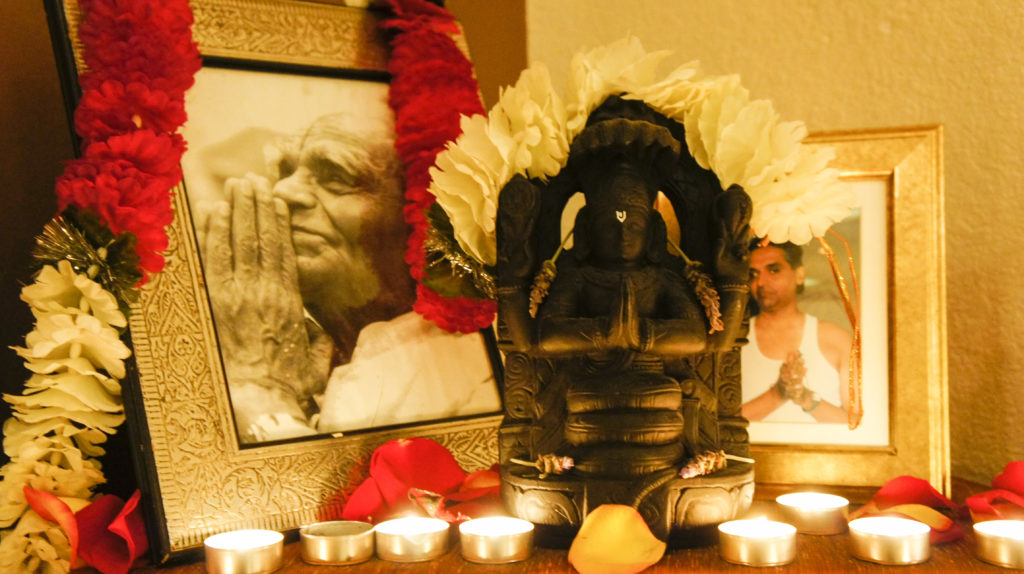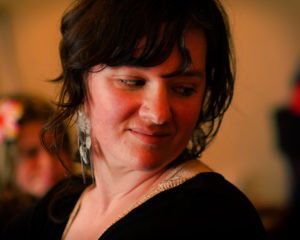
Join us for an evening of uplifting and soulful chanting, community and chai!
Francesca will lead us in kirtan, a joyful practice of call-and-response chanting and devotional practice of Bhakti Yoga. Singing as a group connects us as a community and is opportunity to open the heart, still the mind and take refuge in our innermost experience of the Divine. No musical experience necessary, just an open heart and mind.
Friday, April 21 | 7-8:30pm
In preparation for this event, Adeline Yoga instructor Leah Flaks interviewed Francesca Nicosia to learn more about kirtan. Read on below, and join us on Friday, April 21 at 7pm for an evening of music and fellowship!
Leah: What is kirtan and how is it different from other kinds of chanting we do at Adeline? Why do we chant in Sanskrit?
Francesca: Kirtan is a practice of call-and-response chanting. A lead singer calls out a phrase—typically a simple Sanskrit mantra or names given to the divine—and the group responds.
At Adeline Yoga, we chant an invocation to the sage Patanjali at the beginning of class as a way to honor the lineage of B.K.S. Iyengar and those who came before to bring us the teachings of yoga. Traditional Vedic chanting is oriented around the study of scriptures and the meter and tone of these chants come from precision in pronunciation and Sanskrit grammar. Each syllable in Sanskrit contains prana, or energetic vibration associated with it. Learning to chant in this fashion taps into a very special and ancient tradition.
Kirtan, on the other hand, has no fixed form and sets mantras to a melody accompanied by musical instruments. Kirtan has a long history throughout the Indian subcontinent with variations in form depending on the region. There is no right or wrong way to sing kirtan. It does not have to be sung in Sanskrit—kirtan and bhajans (devotional songs) can be sung in any language. Here in the U.S., kirtan might even include English words, although I have a preference for chanting in Sanskrit because the energy of the sound vibration is so profound and transformative.
What is the call and response all about? Why sing kirtan and why do some people dance?
When we chant in call and response, on a practical level the leader chants a line or phrase and you can hear the words and melody. On a more subtle level, the call and response is a reflection of the order of the universe and the interaction between self and the divine, purusa and prakriti. The people leading the chants and those responding merge into song together where there is no distinction between audience and performers, singer and song. Although there is always someone leading, the practice itself becomes our teacher.
Kirtan calls for an outward expression of joy in a different way than asana, pranayama or seated meditation. Sometimes you experience a profound stillness and feel rooted to your seat. Other times, the music and prana moves through you and you’ll want to clap, jump and dance. You have to just open your heart, immerse yourself in the experience and be willing to accept the nectar of the practice in whatever form it takes.
What does kirtan mean to you?
I couldn’t imagine my life without chanting. For me, kirtan and chanting are the easiest way for me to still the fluctuations of the mind. This is the essence of what yoga is all about—yogah citta vrtti nirodah. When I chant, my mind gets focused and clear, my heart opens and creates a space inside full of love, refuge, quietude, bliss, whatever it is that is needed.
I grew up in a musical family—my mother was an opera singer and my father an organist—and from a young age I sang in school and church choirs. Growing up with parents whose dharma was to lead people in prayer and worship through music in a Christian tradition made an imprint on me that I didn’t realize until years after leaving the church of my youth behind me. I started practicing asana and meditating when I went to college. I later discovered devotional chanting when studying abroad in Northern India. In 2005, I moved into Shoshoni Yoga Retreat in Colorado for a yoga teacher-training program. At the ashram, chanting was an integral part of daily practice, both traditional Vedic chanting, japa mantra repetition, and of course kirtan. I was blessed to learn from and play with members of Shiva’s Garden, the ashram’s acclaimed kirtan band. Because I played the piano, someone put a harmonium (an accordion-like keyboard instrument) in front of me, and the rest is history. Or perhaps it’s more of an unfolding present and future to see where this path takes me.
Kirtan and chanting have become my musical prayer on the path of bhakti yoga, the yoga of devotion. There can be a devotional quality to any yogic practice, but chanting and singing for me cultivates a certain sweetness unlike anything else. I’m happier and perhaps happiest when I’m chanting.

Is it for everybody? Because I’m not sure it’s for me. Is kirtan congruent with Iyengar Yoga?
Anyone can chant, you don’t need to have any musical experience. It doesn’t matter what you sound like, only that you open yourself to having no expectations or inhibitions. Mr. Iyengar didn’t call his sadhana Iyengar Yoga, he called it Patanjali Yoga, after the sage Patanjali and the path of yoga he set out in the Yoga Sutras.
There is a connection between asana and pranayama in the practice of chanting. Asana helps to prepare the body for sitting, although in kirtan we are free to sit, sway, move around and even dance if you feel so moved. Pranayama helps to develop breath awareness and lung capacity on a physical level and also attune us to the subtle energy of the breath. So both of these limbs of yoga can prepare the body for chanting. I also feel that kirtan and chanting can be a gateway to other aspects of yoga, to have an experience of your connection to the divine that you can carry with you and tap into anytime, anywhere. The mantras we chant carry with them a potent vibration that works on us in subtle ways over time.
What are the benefits of singing kirtan? Why do we sing as a group?
Singing in a group brings us together in community. Right now, cultivating community is so important. Just like when we come to the studio for an asana class, the experience of practicing in a group is different than when we are by ourselves, even though asana and chanting are ultimately an individual endeavor. We come to class to learn from our teachers and take something home with us to refine and polish over time. There is something powerful about coming together to sing and chant. The sound vibrations are amplified. There is research that shows that when people sing together, their heart beats sync up and there are positive neurological and hormonal effects that both calm and energize the nervous system. Kirtan reminds us not to take ourselves so seriously. Most importantly, kirtan opens the heart, and we can always use more of that.

Thank you Francesca, for opening your heart to all of us!
Community Kirtan with Francesca & Friends
April 21, 7:00pm
for more info, visit: https://adelineyoga.com/event/community-kirtan/
 Francesca Nicosia has been chanting and leading kirtan for over a decade. She grew up in a musical family — her mother an opera singer and father an organist — and started playing piano and singing in choirs at a young age. She was first exposed to the sacred music of India during a semester abroad in Northern India. While living at Shoshoni Yoga Retreat in Colorado, chanting became an integral part of her daily practice. She was blessed to play with members of the ashram’s acclaimed kirtan band, Shiva’s Garden and study classical Indian singing with Megan Yalkut. Francesca regularly led kirtan at the Eldorado Mountain Yoga Ashram and the Denver Ashram before moving to the Bay Area in 2010. Francesca is an active member of the Adeline Community. She teaches Yoga for Every Body on Monday nights and is a graduate of the Sadhana Studies program. Chanting is her musical prayer and offering on the path of devotion, or Bhakti Yoga. She is grateful to share her deep love for this devotional practice as a way to open the heart, still the mind and take refuge in our innermost experience of the Divine. Stay connected with Francesca at her website http://francescanicosia.com/ and on facebook https://www.facebook.com/shantiyogakirtan/.
Francesca Nicosia has been chanting and leading kirtan for over a decade. She grew up in a musical family — her mother an opera singer and father an organist — and started playing piano and singing in choirs at a young age. She was first exposed to the sacred music of India during a semester abroad in Northern India. While living at Shoshoni Yoga Retreat in Colorado, chanting became an integral part of her daily practice. She was blessed to play with members of the ashram’s acclaimed kirtan band, Shiva’s Garden and study classical Indian singing with Megan Yalkut. Francesca regularly led kirtan at the Eldorado Mountain Yoga Ashram and the Denver Ashram before moving to the Bay Area in 2010. Francesca is an active member of the Adeline Community. She teaches Yoga for Every Body on Monday nights and is a graduate of the Sadhana Studies program. Chanting is her musical prayer and offering on the path of devotion, or Bhakti Yoga. She is grateful to share her deep love for this devotional practice as a way to open the heart, still the mind and take refuge in our innermost experience of the Divine. Stay connected with Francesca at her website http://francescanicosia.com/ and on facebook https://www.facebook.com/shantiyogakirtan/.
 Leah Flaks began practicing yoga after a debilitating dance injury in college led her to the Iyengar Yoga practice. Be sure to ask her about meeting BKS Iyengar in Berkeley’s Tilden Park in the 1980s. If you are lucky, she will show you the picture of her demonstrating trikonasana with BKS Iyengar himself. Leah has years of experience teaching beginner yoga and is happy to teach at Adeline Yoga where the teachers and students love the Iyengars and believe yoga is for everybody. Leah is Adeline Yoga’s studio manager. She thrives on welcoming new and long-standing students to the yoga studio. She has completed year one of Adeline Yoga’s Teacher Training Program and will soon be going up for Iyengar Yoga certification.
Leah Flaks began practicing yoga after a debilitating dance injury in college led her to the Iyengar Yoga practice. Be sure to ask her about meeting BKS Iyengar in Berkeley’s Tilden Park in the 1980s. If you are lucky, she will show you the picture of her demonstrating trikonasana with BKS Iyengar himself. Leah has years of experience teaching beginner yoga and is happy to teach at Adeline Yoga where the teachers and students love the Iyengars and believe yoga is for everybody. Leah is Adeline Yoga’s studio manager. She thrives on welcoming new and long-standing students to the yoga studio. She has completed year one of Adeline Yoga’s Teacher Training Program and will soon be going up for Iyengar Yoga certification.
